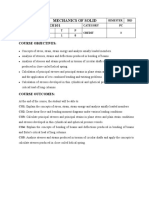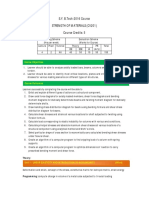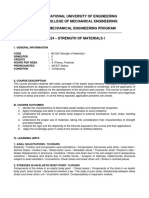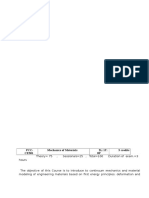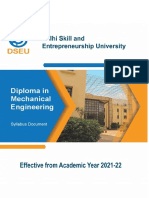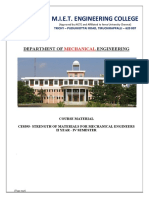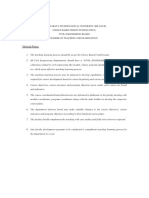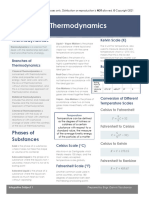202051: Strength of Materials
Teaching Scheme: Credits Examination Scheme:
TH: 04 hr/week Th:04 TH In-Sem: 50
End-Sem: 50
PR: 02 hrs/week PR/OR/TW:01 PR: --
OR: 50
TW: --
Prerequisites: -
1. Fundamentals of engineering mechanics
2. Analysis of forces and moments
3. Laws of motion, kinetics, kinematics
4. Algebra and trigonometry
Course Objectives:
To understand
Mechanical behavior of the body by determining the stresses, strains and deflections
produced by the loads up to the elastic limit.
Fundamental concepts related to deformation, strain energy, moment of inertia, load
carrying capacity, slope an deflection of beams, shear forces, bending moments,
torsional moments, column and struts, principal stresses and strains and theories of
failure
Course Outcomes:
Student should be able to
Apply knowledge of mathematics, science for engineering applications
Design and conduct experiments, as well as to analyze and interpret data
Design a component to meet desired needs within realistic constraints of health and
safety
Identify, formulate, and solve engineering problems
Practice professional and ethical responsibility
Use the techniques, skills, and modern engineering tools necessary for engineering
practice
Course Contents
�Unit I Simple stresses and strains (8 Hrs)
Stress, strain, Hooke’s law, Poisson’s ratio, Modulus of Elasticity, Modulus of Rigidity, Bulk
Modulus. Interrelation between elastic constants,
Stress-strain diagram for ductile and brittle materials, factor of safety.
Stresses and strains in determinate and indeterminate, homogeneous and composite bars under
concentrated loads and self weight.
Temperature stresses in simple members.
Unit II Shear Force and Bending Moment Diagrams (8 Hrs)
Shear force and bending moment diagrams for statically determinate beam due to concentrated
load, uniformly distributed load, uniformly varying load and couple, Relationship between rate
of loading, shear force and bending moment.
Maximum bending moment and position of points of contra flexure.
Unit III Stresses in Machine Elements (8 Hrs)
Bending stresses : Theory of simple bending, assumptions, derivation of flexural formula,
second moment of area of common cross sections (rectangular, I,T,C ) with respect to
centroidal and parallel axes, bending stress distribution diagrams, moment of resistance and
section modulus.
Shear stresses: Concept, derivation of shear stress distribution formula, shear stress
distribution diagrams for common symmetrical sections, maximum and average shears stresses,
shear connection between flange and web.
Unit IV (8 Hrs)
Slope and deflection of beams: Relation between bending moment and slope, slope and
deflection of determinate beams, double integration method (Macaulay’s method), derivation of
formula for slope and deflection for standard cases.
Strain energy: Strain energy due to axial load (gradual, sudden and impact), strain energy due
to bending and torsion.
Unit V (8 Hrs)
Torsion: Stresses, strain and deformations in determinate shafts of solid and hollow,
homogeneous and composite circular cross section subjected to twisting moment, derivation of
torsion equation, stresses due to combined torsion, bending and axial force on shafts.
Buckling of columns: Concept of buckling of columns, derivation of Euler’s formula for
buckling load for column with hinged ends, concept of equivalent length for various end
conditions, limitations of Euler’s formula, Rankine’s formula, safe load on columns
�Unit VI (8 Hrs)
Principal stresses and strains: Normal and shear stresses on any oblique plane. Concept of
principal planes, derivation of expression for principal stresses and maximum shear stress,
position of principal planes and planes of maximum shear.
Graphical solution using Mohr’s circle of stresses. Principal stresses in shaft subjected to
torsion, bending moment and axial thrust (solid as well as hollow),
Concept of equivalent torsional and bending moments.
Theories of elastic failure: Maximum principal stress theory, maximum shear stress theory,
maximum distortion energy theory – their applications and limitations.
Books:
Text:
1. G. H. Ryder- Strength of Materials- 3rd Edition, Macmillan Pub, India
2. S.S. Rattan - Strength of Material – Tata McGraw Hill Publication Co. Ltd. S.
3. Ramamurtham - Strength of material - Dhanpat Rai Publication.
4. Timoshenko and Young - Strength of Materials - CBS Publication
Reference:
1. Beer and Johnston - Strength of materials - CBS Publication.
2. E.P. Popov - Introduction to Mechanics of Solids - Prentice Hall Publication.
3. Singer and Pytel - Strength of materials - Harper and row Publication.
4. B.K. Sarkar - Strength of Material - Tata McGraw Hill New Delhi.
List of Practicals:
(Any 6 out of 1 to 8 and any 2 out of 9 to 11)
1. Tension test for aluminum alloy and mild steel using extensometer.
2. Tension test for brass using extensometer
3. Shear test of ductile material on Universal Testing Machine.
4. Experimental verification of flexural formula in bending for cantilever beam.
5. Experimental verification of flexural formula in bending for simply supported beam.
6. Measurement of stresses and strains in beams for different end conditions using strain
gauges.
7. Experimental verification of torsion formula for circular bar.
8. Experimental verification of von Mises theory of failure.
Graphical simulation of - (using suitable software like MD-Solids, Matlab, MS-Excel
etc.)
9. Shear force and bending moment diagrams with different end conditions.
10. Slope and deflection.
11. Principal stresses through graphical and analytical method.











